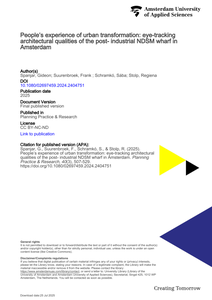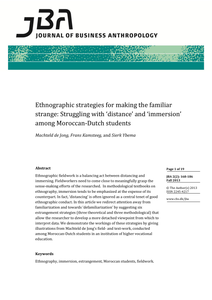The capacity to deal with digital transformation is a valuable asset for established organizations, and employees play a crucial role in this process. This study contributes to the understanding of employees’ sensemaking of digital transformation in the tour operating industry. Using prior digital transformation research, construal-level theory (CLT), and dynamic change perspectives, our scholarly work focuses on the complexities of organizational change in a digital transformation context. Although employees generally support digital transformation, our findings show that their perceptions change over time across a range of specific challenges experienced during the employee change journey. Our findings stress the importance of adopting a social exchange lens in digital transformation knowledge as this represents deep structure change that might cause well-designed transformation processes to fail. Implications for hospitality and tourism management are discussed.
MULTIFILE
World globalisation drives companies to undertake international expansion with the aim of retaining or growing their businesses. When companies globalize, managers encounter new challenges in making international marketing strategy (IMS) decisions, which are influenced by perceived cultural and business distance between their home- and foreign country. Telkom Indonesia International (Telin) was formed by Telkom Indonesia (i.e. the state-owned company in the telecommunication industry in Indonesia) to engage in international business within a global market. The central question in this study is to what extent do managers’ perceived cultural and business distance between home- and foreign country influence their IMS decisions? A mixed research strategy will be employed by applying qualitative and quantitative methods concurrently. The data collection will involve interviews with CEOs and managers, alongside a web survey to 55 managers of Telkom's. Results suggest important consequences for IMS decisions and emphasizes the need for dialogue on perceptions of cultural and business characteristics of countries.
DOCUMENT

For environmental governance to be more effective and transformative, it needs to enhance the presence of experimental and innovative approaches for participation. This enhancement requires a transformation of environmental governance, as too often the (public) participation process is set up as a formal obligation in the development of a proposed intervention. This article, in search of alternatives, and in support of this transformation elaborates on spaces where participatory and deliberative governance processes have been deployed. Experiences with two mediated participation methodologies – community art and visual problem appraisal – allow a demonstration of their potential, relevance and attractiveness. Additionally, the article analyzes the challenges that result from the nature of these arts-based methodologies, from the confrontational aspects of voices overlooked in conventional approaches, and from the need to rethink professionals’ competences. Considering current environmental urgencies, mediated participation and social imaginaries still demonstrate capacities to open new avenues for action and reflection.
MULTIFILE

Many organizations use business process management to manage and model their processes. Currently, flow-based process formalisms, such as BPMN, are considered the standard for modeling processes. However, recent literature describes several limitations of this type of formalism that can be solved by adopting a constraint-based formalism. To preserve economic investments in existing process models, transformation activities needed to be limited. This paper presents a methodical approach for performing the tedious parts of process model transformation. Executing the method results in correctly transformed process models and reduces the effort required for converting the process models.
DOCUMENT

Urban densification continues unabated, even as the possible consequences for users’ eye-level experiences remain unknown. This study addresses these consequences. In a laboratory setting, images of the NDSM wharf were shown to university students primed for one of three user groups: residents, visitors and passers-by. Their visual experiences were recorded using eye-tracking and analyzed in combination with surveys on self-reported appreciation and restorativeness. On-site surveys were also administered among real users. The results reveal distinct eye-movement patterns that point to the influence of environmental roles and tasks and how architectural qualities steer people’s visual experience, valence and restoration.
DOCUMENT

Author supplied: "This paper gives a linearised adjustment model for the affine, similarity and congruence transformations in 3D that is easily extendable with other parameters to describe deformations. The model considers all coordinates stochastic. Full positive semi-definite covariance matrices and correlation between epochs can be handled. The determination of transformation parameters between two or more coordinate sets, determined by geodetic monitoring measurements, can be handled as a least squares adjustment problem. It can be solved without linearisation of the functional model, if it concerns an affine, similarity or congruence transformation in one-, two- or three-dimensional space. If the functional model describes more than such a transformation, it is hardly ever possible to find a direct solution for the transformation parameters. Linearisation of the functional model and applying least squares formulas is then an appropriate mode of working. The adjustment model is given as a model of observation equations with constraints on the parameters. The starting point is the affine transformation, whose parameters are constrained to get the parameters of the similarity or congruence transformation. In this way the use of Euler angles is avoided. Because the model is linearised, iteration is necessary to get the final solution. In each iteration step approximate coordinates are necessary that fulfil the constraints. For the affine transformation it is easy to get approximate coordinates. For the similarity and congruence transformation the approximate coordinates have to comply to constraints. To achieve this, use is made of the singular value decomposition of the rotation matrix. To show the effectiveness of the proposed adjustment model total station measurements in two epochs of monitored buildings are analysed. Coordinate sets with full, rank deficient covariance matrices are determined from the measurements and adjusted with the proposed model. Testing the adjustment for deformations results in detection of the simulated deformations."
MULTIFILE

This article deals with automatic object recognition. The goal is that in a certain grey-level image, possibly containing many objects, a certain object can be recognized and localized, based upon its shape. The assumption is that this shape has no special characteristics on which a dedicated recognition algorithm can be based (e.g. if we know that the object is circular, we could use a Hough transform or if we know that it is the only object with grey level 90, we can simply use thresholding). Our starting point is an object with a random shape. The image in which the object is searched is called the Search Image. A well known technique for this is Template Matching, which is described first.
DOCUMENT
While tourism and air transport are recovering from the impacts of the Covid pandemic, it seems timely to draw a synthetic view of future stakes combining the following topics: the greenhouse gas emissions scenarios for tourism, regarding which recent work has improved their understanding; the climatic impact of aviation, almost 60% of which is due to non-CO 2 emissions; alternative fuels (biofuels, E-fuels, hydrogen) and engine designs (fuel cells...) which are complex and controversial issues, and whose potentials should be assessed regarding their timing, environmental impacts, and their ability to meet long distance travel requirements. This paper analyses the extent to which the new options regarding fuels and engines can help decarbonize tourism and air transport. The answer is that they can partly contribute but do not render obsolete previous work on substitutions between types of tourism (short versus long distance...), between transport modes (ground transport versus air), length of stay, etc. Following this step, the paper deals with the position of aviation players and the type of arguments they use. We conclude on the necessity to make strategic choices among the options to avoid wasting investments.
MULTIFILE
Ethnographic fieldwork is a balancing act between distancing and immersing. Fieldworkers need to come close to meaningfully grasp the sense-making efforts of the researched. In methodological textbooks on ethnography, immersion tends to be emphasized at the expense of its counterpart. In fact, ‘distancing’ is often ignored as a central tenet of good ethnographic conduct. In this article we redirect attention away from familiarization and towards ‘defamiliarization’ by suggesting six estrangement strategies (three theoretical and three methodological) that allow the researcher to develop a more detached viewpoint from which to interpret data. We demonstrate the workings of these strategies by giving illustrations from Machteld de Jong’s field- and text-work, conducted among Moroccan-Dutch students in an institution of higher vocational education.
DOCUMENT

Ethnographic fieldwork is a balancing act between distancing and immersing. Fieldworkers need to come close to meaningfully grasp the sense-making efforts of the researched. In methodological textbooks on ethnography, immersion tends to be emphasized at the expense of its counterpart. In fact, ‘distancing’ is often ignored as a central tenet of good ethnographic conduct. In this article we redirect attention away from familiarization and towards ‘defamiliarization’ by suggesting six estrangement strategies (three theoretical and three methodological) that allow the researcher to develop a more detached viewpoint from which to interpret data. We demonstrate the workings of these strategies by giving illustrations from Machteld de Jong’s field- and text-work, conducted among Moroccan-Dutch students in an institution of higher vocational education.
DOCUMENT
